 Granny is dead. In August of last year, we posted Orca “Granny,” 105 Years Old, Still Swimming the Pacific about the oldest member of the ” J” pod of Puget Sound orcas, and also the known living orca. Sadly, in January, the whale dubbed J2 by researchers, but nicknamed “Granny,” was no longer seen swimming with her pod and is presumed to have died. Even orcas whales cannot live forever, but nevertheless, Granny’s passing may be a sign of a much greater problem for orcas, also known as killer whales, in the Pacific Northwest. Because of a decrease in wild salmon, the orcas may be starving. Alarmingly, a similar problem appears to be facing orcs in the Antarctic where a decrease in the seal population may be threatening orca survival.
Granny is dead. In August of last year, we posted Orca “Granny,” 105 Years Old, Still Swimming the Pacific about the oldest member of the ” J” pod of Puget Sound orcas, and also the known living orca. Sadly, in January, the whale dubbed J2 by researchers, but nicknamed “Granny,” was no longer seen swimming with her pod and is presumed to have died. Even orcas whales cannot live forever, but nevertheless, Granny’s passing may be a sign of a much greater problem for orcas, also known as killer whales, in the Pacific Northwest. Because of a decrease in wild salmon, the orcas may be starving. Alarmingly, a similar problem appears to be facing orcs in the Antarctic where a decrease in the seal population may be threatening orca survival.
A fascinating short video by the BBC. Apparently, the mobula rays which make the biggest slash when leaping from the ocean have the greatest chance of finding a mate. Often referred to as “devil rays”, “flying mobula” or simply “flying rays”, they grow to up to 17 ft from wing tip to wing tip and can weigh over a ton. They are capable of truly impressive belly flops.
 NASA scientists this week, made an exciting announcement. They have discovered the necessary chemical mix to potentially support life in the sea beneath a polar ice cap of Saturn’s moon, Enceladus. What they have observed on Enceladus is similar to the characteristics of deep-sea hydrothermal vents on Earth.
NASA scientists this week, made an exciting announcement. They have discovered the necessary chemical mix to potentially support life in the sea beneath a polar ice cap of Saturn’s moon, Enceladus. What they have observed on Enceladus is similar to the characteristics of deep-sea hydrothermal vents on Earth.
As the spacecraft Cassini passed by Enceladus, it recorded the chemical contents of gas plumes from the icy surface near the south pole. The plumes were primarily composed of water erupting through cracks in the surface ice. They are believed to originate from hydro-thermal vents in the Enceladus seafloor. In the latest recordings, the spacecraft Cassini also found significant hydrogen in the mix. Hydrogen is an important component to provide the energy to support life. With the addition of hydrogen, Enceladus appears to have all the right chemical building blocks for life. “Now, Enceladus is high on the list in the solar system for showing habitable conditions,” said Hunter Waite, leader of the Cassini Ion and Neutral Mass Spectrometer team at the Southwest Research Institute in San Antonio and lead author of the Enceladus study, to CNN.
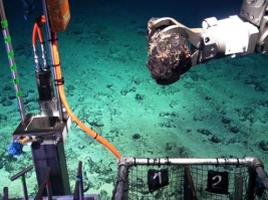 Deep-sea mining has long been a controversial subject. For the last 50 years, proponents have called for the mining of silver, gold, copper, manganese, cobalt, and zinc from the seafloor, while environmentalists have argued that seabed mining should not be permitted because of the potential damage to deep-sea ecosystems. So far, no actual commercial mining has taken place although at least one project is scheduled to start in 2018. Recently a new discovery has, perhaps somewhat paradoxically, renewed interest in undersea mining in order to help produce green energy.
Deep-sea mining has long been a controversial subject. For the last 50 years, proponents have called for the mining of silver, gold, copper, manganese, cobalt, and zinc from the seafloor, while environmentalists have argued that seabed mining should not be permitted because of the potential damage to deep-sea ecosystems. So far, no actual commercial mining has taken place although at least one project is scheduled to start in 2018. Recently a new discovery has, perhaps somewhat paradoxically, renewed interest in undersea mining in order to help produce green energy.
Tellurium is a rare metallic element, number 52 on the Periodic Table, which is a key component used in the fabrication of advanced solar panels. The BBC recently reported that British scientists exploring an underwater mountain in the Atlantic Ocean have discovered a treasure trove of rare minerals, including a particularly rich source of tellurium. The tellurium was reported to be in concentrations 50,000 times higher than in deposits on land. In addition to the tellurium, The rock samples also contained rare earth elements that are used in wind turbines and electronics.
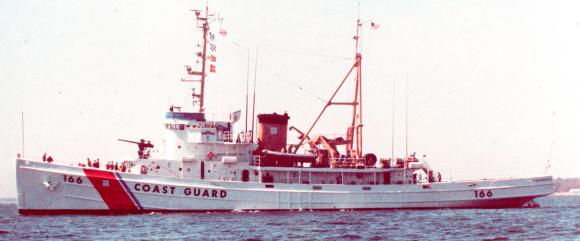 Last October, we posted that the USCG Cutter Tamaroa, ex-USS Zuni, was to be reefed by the end of the month. The 205-foot ex-fleet ocean/salvage tug and ex-Coast Guard Cutter was to be sunk as part of an artificial reef about 26 miles off Cape May, NJ. Sinking the ship on October 30th was to coincide with the the 25th anniversary of the “Perfect Storm” of 1991. The sinking was delayed, however, awaiting test results to document that the 73 year old ship was free of cancer-causing PCBs. The tests took took longer than had been originally anticipated. Now, the storied ship will will finally be sent to the bottom next Tuesday, weather permitting.
Last October, we posted that the USCG Cutter Tamaroa, ex-USS Zuni, was to be reefed by the end of the month. The 205-foot ex-fleet ocean/salvage tug and ex-Coast Guard Cutter was to be sunk as part of an artificial reef about 26 miles off Cape May, NJ. Sinking the ship on October 30th was to coincide with the the 25th anniversary of the “Perfect Storm” of 1991. The sinking was delayed, however, awaiting test results to document that the 73 year old ship was free of cancer-causing PCBs. The tests took took longer than had been originally anticipated. Now, the storied ship will will finally be sent to the bottom next Tuesday, weather permitting.
Tamaroa may be best known for rescuing the crew of the yacht Satori, as well as the crew of a downed Air National Guard helicopter during the “Perfect Storm”, as described in Sebastian Junger’s book of the same name.
Captains on the new Citywide Ferry service in New York harbor are receiving training on a state-of-the-art simulator at SUNY Maritime College at Fort Schyler.
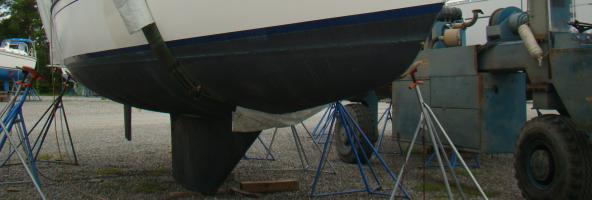 I am sure that I am not the only one who really does not like anti-fouling bottom paint. By definition, anti-fouling bottom paint is a biocide — it kills life — which is fine and dandy if that life is a barnacle. It is not great as I wonder how much dust is getting past my respirator as I prep the bottom of the boat between seasons. I recently learned about ultrasonic anti-fouling systems. I know that I am a bit late to the party as it has been around commercially for at least five or six years now, but it doesn’t seem to be widely accepted quite yet.
I am sure that I am not the only one who really does not like anti-fouling bottom paint. By definition, anti-fouling bottom paint is a biocide — it kills life — which is fine and dandy if that life is a barnacle. It is not great as I wonder how much dust is getting past my respirator as I prep the bottom of the boat between seasons. I recently learned about ultrasonic anti-fouling systems. I know that I am a bit late to the party as it has been around commercially for at least five or six years now, but it doesn’t seem to be widely accepted quite yet.
Norway’s Stad Peninsula divides the Norwegian Sea to the north and the North Sea to the south. The seas, winds, currents and weather are extremely dangerous for any ship attempting to round the peninsula. Now, Norway intends to bore through the rocky shores to cut a passageway to create a short-cut for ocean going ships. The tunnel will be the first tunnel intended for ocean-going ships. The tunnel will be 1,700 meters long by 37 meters high and 26.5 meters wide and is expected to cost at least 2.7bn kroner ($380m). A tunnel through the Stadt peninsula was first proposed in 1870.
Real pirates tended to have very short careers. Edward Teach, better known as Blackbeard, was pretty typical, being active for only about two years from 1716 to 1718, before losing his head. Cartoon pirates, however, do generally much better. Captain Pugwash, a British cartoon pirate created by John Ryan, originated as a cartoon in newspapers and books in the 1950s, and later in various TV series through the 90s.
In the books and TV series, Captain Horatio Pugwash is a somewhat bombastic yet simple-minded captain who sails the high seas in his ship called the Black Pig, assisted by cabin boy Tom, pirates Willy and Barnabas, and Master Mate. His mortal enemy is Cut-Throat Jake, captain of the Flying Dustman. Oddly, while a pirate captain, Pugwash never seems to engage in much piracy and is often saved by Tom, the cabin boy, who is the smartest member of the crew. Here is Episode 1 from the 1974 series.

Graphene, Image: AlexanderAlUS
Recently science writers at various news outlets have been gushing over an announcement that scientists have been able to use graphene to remove the salt from seawater. CNBC lead with the exuberant headline, “Carbon-based filter which turns seawater into drinking water could help millions.” Science Alert’s headline was “Scientists Have Invented a Graphene-Based Sieve That Turns Seawater Into Drinking Water — Holy crap.” While the enthusiasm is evident, what is not so clear is whether there is anything here to get so excited about.
Graphene is the latest and greatest wonder material. Graphene is a carbon lattice one molecule thick which has some amazing properties. It is something like 200 times stronger than steel and transmits heat and electricity extremely efficiently. Potentially, it could be used for a myriad of purposes, including generating electricity, building far more efficient batteries, better and faster microchips and far stronger, lighter materials. Richard Branson of Virgin Airlines, has predicted airplanes built of graphene in not the too distant future. And yes, potentially it could make desalination more efficient.
The claims for desalinization actually made by the scientists are somewhat more tentative than the headlines. As reported by CNBC:
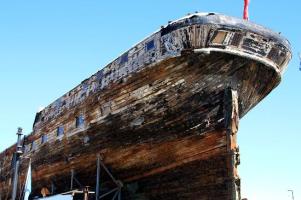 At the end of January, we posted Clipper Ship City of Adelaide Still Not Quite Home, where we noted: “The ship is sitting on a deck barge as a “temporary” accommodation at Port Adelaide’s Dock 1, with no permanent dock space yet in sight. The State Government’s commitment to provide a permanent location for the largely privately funded project remains unfulfilled.”
At the end of January, we posted Clipper Ship City of Adelaide Still Not Quite Home, where we noted: “The ship is sitting on a deck barge as a “temporary” accommodation at Port Adelaide’s Dock 1, with no permanent dock space yet in sight. The State Government’s commitment to provide a permanent location for the largely privately funded project remains unfulfilled.”
Now there is good news. The State Government of South Australia has announced plans for a permanent home of the historic clipper ship, the oldest surviving clipper in the world, as part of a proposed Port Adelaide marine precinct. The ship will be moved to the port’s Dock 2, and include a pedestrian bridge and road access.
Built in Sunderland, England, in 1864, the City of Adelaide is a composite clipper ship. Like the somewhat newer Cutty Sark, a composite ship has wooden planks over an iron keel, frames and girders. City of Adelaide made 23 annual return voyages from London and Plymouth to Adelaide, South Australia. An estimated 250,000 Australians can trace their ancestry to passengers who arrived on the ship.
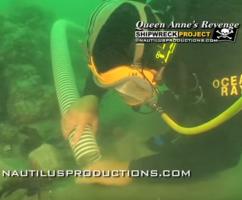 A video producer who produced video of the excavation of a pirate ship is now suing the State of North Carolina and others for piracy. Nautilus Productions, which served as a videographer for the Queen Anne’s Revenge shipwreck project, is charging copyright infringement and arguing against the constitutionality of a state law regarding property rights in its suit against the N.C. Department of Natural and Cultural Resources, the State of North Carolina and Friends of Queen Anne’s Revenge. U.S. District Judge Terrence W. Boyle recently declined a motion by North Carolina state attorneys to dismiss a lawsuit.
A video producer who produced video of the excavation of a pirate ship is now suing the State of North Carolina and others for piracy. Nautilus Productions, which served as a videographer for the Queen Anne’s Revenge shipwreck project, is charging copyright infringement and arguing against the constitutionality of a state law regarding property rights in its suit against the N.C. Department of Natural and Cultural Resources, the State of North Carolina and Friends of Queen Anne’s Revenge. U.S. District Judge Terrence W. Boyle recently declined a motion by North Carolina state attorneys to dismiss a lawsuit.
The suit alleges that the defendants made illegal copies of Nautilus’ videography, and then persuaded the N.C. General Assembly to pass an “unconstitutional law” known as “Blackbeard’s Law” in an attempt to justify pirating work from Nautilus. Blackbeard’s Law states that videos, photos and other documentary work in the state’s possession are public documents and there are no restrictions on their use.
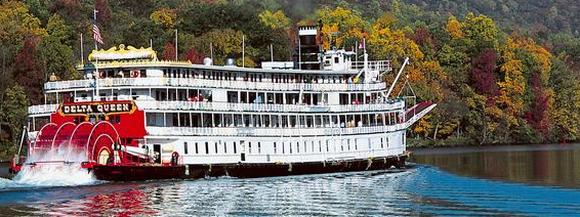 Great news. The Senate has passed a waiver for the historic riverboat steamer Delta Queen from the Safety of Life at Sea (SOLAS) regulations, moving it one step closer to returning to service.
Great news. The Senate has passed a waiver for the historic riverboat steamer Delta Queen from the Safety of Life at Sea (SOLAS) regulations, moving it one step closer to returning to service.
For several years now, we have been posting about the struggle to restore the historic riverboat steamer Delta Queen and to return her to operation on the Mississippi and other inland rivers. The reported $5 million restoration of the 1927-built stern-wheel steamboat has been held up by the need for a Congressional SOLAS waiver. The Delta Queen operated with a series of two year waivers from 1966 through 2007. The waiver still needs to approved by the House of Representatives. A similar waiver was passed by the House in 2013, but blocked by the Senate.
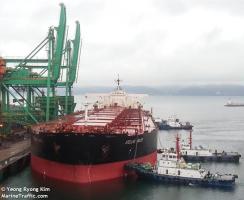 So far, only two of the crew of 24 have been rescued after the Very Large Ore Carrier (VLOC) Stellar Daisy capsized and sank suddenly on Friday, March 31st. The 266,00 DWT Marshall Island registered bulk carrier was reported to have been in calm conditions, roughly 2000 miles off Montevideo, Uruguay, when she capsized. The ship departed from Brasil bound for China on March 26 with a full load of iron ore. The Stellar Daisy had a crew of 14 Filipinos and eight South Koreans.
So far, only two of the crew of 24 have been rescued after the Very Large Ore Carrier (VLOC) Stellar Daisy capsized and sank suddenly on Friday, March 31st. The 266,00 DWT Marshall Island registered bulk carrier was reported to have been in calm conditions, roughly 2000 miles off Montevideo, Uruguay, when she capsized. The ship departed from Brasil bound for China on March 26 with a full load of iron ore. The Stellar Daisy had a crew of 14 Filipinos and eight South Koreans.
On Friday, someone on the ship sent a text message to Polaris Shipping, the ship’s owner, saying the freighter was taking on water. The ship managers attempted to contact the ship but to no avail. Not long after, an emergency rescue beacon was activated.
The two Filipino crew members who were later rescued reported that the Stellar Daisy had developed a 15 degree list, making the ship’s boats unlaunchable. One of the men escaped on a ship’s life raft and the other jumped into the water and swam away from the capsizing ship. The capsize was reported to have taken place in only about 5 minutes. The survivors said that they saw cracks in the plating on the main deck through which water was flooding in.
The Viking longship Draken Harald Hårfagre was hauled out of the water Friday, March 31 at the Mystic Seaport Museum, for several days of routine maintenance in the museum’s shipyard. The vessel has been spending the winter at Mystic Seaport after her 2016 expedition to North America from Norway. See our previous post — The Dragon in Winter — Draken Harald Hårfagre at Mystic Seaport.
They probably shouldn’t have built the gym over the water.
Whale Breaches Before a Basketball Game
Happy April Fool’s Day.
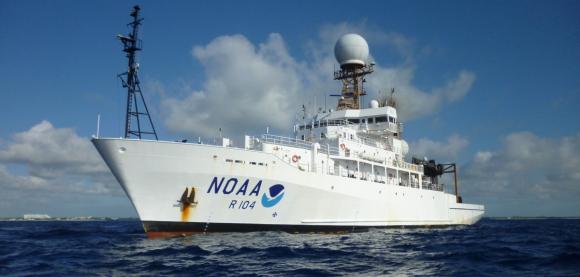 NOAA’s largest oceanographic research vessel, Ronald H. Brown, is based in Charleston, SC, although if you haven’t seen her in her homeport for quite a while, you are not alone. She only recently returned from a record deployment of 1,347 days, which is to say 3 years, 8 months and 7 days in service. During the lengthy deployment, the research vessel spent nearly 800 days at sea and traveled nearly 130,000 miles conducting scientific research and servicing buoys that collect a wide variety of environmental data.
NOAA’s largest oceanographic research vessel, Ronald H. Brown, is based in Charleston, SC, although if you haven’t seen her in her homeport for quite a while, you are not alone. She only recently returned from a record deployment of 1,347 days, which is to say 3 years, 8 months and 7 days in service. During the lengthy deployment, the research vessel spent nearly 800 days at sea and traveled nearly 130,000 miles conducting scientific research and servicing buoys that collect a wide variety of environmental data.
From the NOAA press release:
 We have learned that Joe Stead has passed away. He was a folk singer who sang with everyone from Paul Robeson to Pete Seeger. Around the turn of the 21st century, his focus shifted more toward the sea with his fourth CD ‘Valparaiso Round the Horn.’ In the summer of 2001, he formed the shanty group ‘Kimber’s Men.’ If you are not familiar with Joe, click here for a more complete biography from his website.
We have learned that Joe Stead has passed away. He was a folk singer who sang with everyone from Paul Robeson to Pete Seeger. Around the turn of the 21st century, his focus shifted more toward the sea with his fourth CD ‘Valparaiso Round the Horn.’ In the summer of 2001, he formed the shanty group ‘Kimber’s Men.’ If you are not familiar with Joe, click here for a more complete biography from his website.
Below is a shanty sung by Joe Stead and the Kimber’s Men, “Leave Her Johnny Leave her.” It was the last shanty to be sung before leaving the ship, which seems fitting. “For the voyage is done and the winds don’t blow …”
 Congratulations to Nainoa Thompson who was honored recently with the 2017 Explorers Club Medal, the most prestigious recognition in exploration. The award was presented to Thompson at the 113th Explorers Club Annual Dinner at Ellis Island in New York City. Thompson was recognized for his historic work to revive and perpetuate Polynesian wayfinding and for leading the Mālama Honua Worldwide Voyage as captain and navigator of iconic sailing canoe Hōkūleʻa. Thompson has dedicated his life to teaching the art and values of wayfinding to generations of navigators throughout Polynesia and from across the globe. He was the first Native Hawaiian to practice long-distance wayfinding since the 14th century and consequently inspired a voyaging renaissance throughout the Pacific.
Congratulations to Nainoa Thompson who was honored recently with the 2017 Explorers Club Medal, the most prestigious recognition in exploration. The award was presented to Thompson at the 113th Explorers Club Annual Dinner at Ellis Island in New York City. Thompson was recognized for his historic work to revive and perpetuate Polynesian wayfinding and for leading the Mālama Honua Worldwide Voyage as captain and navigator of iconic sailing canoe Hōkūleʻa. Thompson has dedicated his life to teaching the art and values of wayfinding to generations of navigators throughout Polynesia and from across the globe. He was the first Native Hawaiian to practice long-distance wayfinding since the 14th century and consequently inspired a voyaging renaissance throughout the Pacific.
 Last week, Peruvian customs officials, in the port of Callo, found more than a tonne of cocaine in three shipping containers packed with filets of giant squid about to be loaded on board a ship bound for Belgium. The cocaine was estimated to be worth $85 million.
Last week, Peruvian customs officials, in the port of Callo, found more than a tonne of cocaine in three shipping containers packed with filets of giant squid about to be loaded on board a ship bound for Belgium. The cocaine was estimated to be worth $85 million.
One unusual aspect of the seizure was that roughly half of the cocaine packages were branded in the name of the Argentine football star, Lionel Messi, who plays as a forward for Spanish club FC Barcelona and the Argentina national team. The other half of the cocaine was branded “King” with the the seal of the king of Spain. There is no indication that Messi or the Spanish monarch had anything to do with the cocaine.
